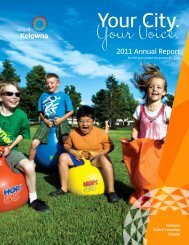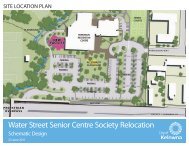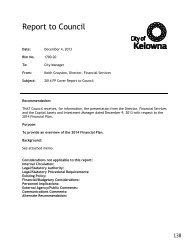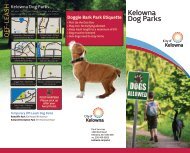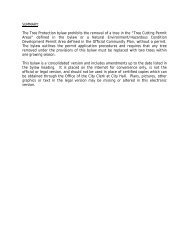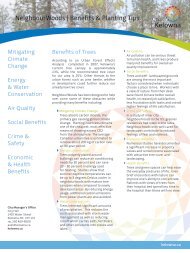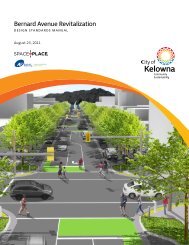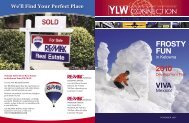Kelowna's Urban Forest: - City of Kelowna
Kelowna's Urban Forest: - City of Kelowna
Kelowna's Urban Forest: - City of Kelowna
Create successful ePaper yourself
Turn your PDF publications into a flip-book with our unique Google optimized e-Paper software.
The top three species in <strong>Kelowna</strong>, Douglas-fir, ponderosa pine and apple,<br />
comprise 76% <strong>of</strong> the total tree canopy, indicating a low level <strong>of</strong> diversity overall.<br />
Most <strong>of</strong> these species are located on natural, undeveloped lands, or on<br />
agricultural lands, indicating the high importance <strong>of</strong> these areas for providing<br />
ecosystem services. As some <strong>of</strong> these areas are developed in the future, some<br />
ecosystem services will be lost and may have to be replaced through<br />
investments in stormwater, water purification or other “grey infrastructure”<br />
improvements.<br />
The major threats to <strong>Kelowna</strong>’s urban forest in the next decade are mountain<br />
pine beetle, development, and wildfire. The model estimates that <strong>Kelowna</strong> has<br />
about 606,000 ponderosa pine trees, with a replacement value <strong>of</strong> $181 million.<br />
According to the provincial government, we are likely to lose about 80% <strong>of</strong> these<br />
trees (primarily mature trees) due to pine beetle.<br />
<strong>Kelowna</strong>’s current tree canopy is only about 13%, on average, although there is<br />
another 27% plantable space. Areas with the highest tree cover include vacant /<br />
wildland (23%), and agriculture and rural lands (15%), while the lowest cover<br />
(3%) occurs on land zoned as commercial / industrial and transportation.<br />
Strategies to enhance the ecological services <strong>of</strong> urban trees in <strong>Kelowna</strong> include:<br />
1) Aiming for species, size and age diversity (reduces the impact <strong>of</strong> pests);<br />
2) Increasing the number <strong>of</strong> healthy trees;<br />
3) Maximizing the use <strong>of</strong> low VOC emitting trees to improve air quality;<br />
4) Sustaining and increasing existing tree cover;<br />
5) Sustaining large, healthy trees (greater benefits per tree);<br />
6) Using long-lived species (reduces carbon emissions from planting and<br />
removal activities);<br />
7) Using low-maintenance trees (reduces fossil fuel requirements for maintaining<br />
vegetation);<br />
8) Planting trees in energy-conserving locations;<br />
9) Planting trees as part <strong>of</strong> transportation corridors (extends the life <strong>of</strong> streets,<br />
reduces carbon dioxide emissions) and parking lots (cooling effect and<br />
reduction <strong>of</strong> VOC emissions from parked vehicles);<br />
10) Planting trees in polluted areas;<br />
11) Avoiding pollution sensitive tree species;<br />
12) Utilizing evergreen trees for particulate matter reduction (year-round removal<br />
<strong>of</strong> pollutants).<br />
<strong>Kelowna</strong>’s <strong>Urban</strong> <strong>Forest</strong>: UFORE Analysis 3



